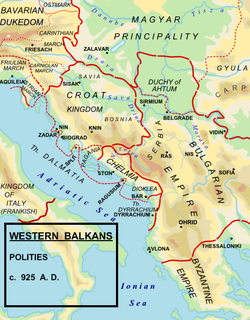- Dalmatia (theme)
-
Not to be confused with the Roman province of Dalmatia, which existed until 476.
Θέμα Δελματίας
Theme of DalmatiaTheme of the Byzantine Empire ca. 870 – 1060s Map of the western Balkans ca. 925 Capital Zadar Historical era Middle Ages - Establishment as a theme ca. 870 - Collapse of Byzantine control 1060s The Theme of Dalmatia (Greek: θέμα Δαλματίας/Δελματίας, thema Dalmatias/Delmatias) was a Byzantine theme (a military-civilian province) on the eastern coast of the Adriatic Sea in Southeastern Europe, headquartered at Zadar.
History
Dalmatia first came under Byzantine control in the 530s, when the generals of Justinian I seized it from the Ostrogoths in the Gothic War. The invasions of the Avars and Slavs in the 7th century destroyed the main cities and overran much of the hinterland, with Byzantine control limited to the islands and certain new coastal cities such as Split and Dubrovnik, while Zara (Zadar) became the local episcopal and administrative center, under an archon.[1]
At the turn of the 9th century, Dalmatia was seized by Charlemagne, but he returned it to Byzantine authority in 812. It is unclear whether the region was under actual rather than nominal Byzantine authority after that; the local cities appear to have been virtually independent. Nevertheless, an archon of Dalmatia is mentioned in the 842/843 Taktikon Uspensky, and a seal of a "strategos of Dalmatia" dated to the first half of the century may indicate the existence of a Dalmatian theme, at least for a short time.[2] Traditionally, however, the establishment of Dalmatia as a regular theme is placed in the early years of the reign of Basil I the Macedonian (r. 867–886), following the expeditions of Niketas Oryphas.[1][2]
In the late 10th and early 11th centuries, Byzantine authority was rivalled by Venice, the Serbian principalities, Croatia and Hungary. Except for Dubrovnik and the southern third of Dalmatia, Byzantine control collapsed in the 1060s. Byzantine predominance was restored under Manuel I Komnenos (r. 1143–1180), but vanished after his death and was replaced by Venetian control.[1]
References
Sources
- Kazhdan, Alexander Petrovich, ed (1991). The Oxford Dictionary of Byzantium. New York, New York and Oxford, United Kingdom: Oxford University Press. ISBN 978-0-19-504652-6. http://books.google.com/books?id=Q3u5RAAACAAJ.
- Nesbitt, John W.; Oikonomides, Nicolas, eds (1991). Catalogue of Byzantine Seals at Dumbarton Oaks and in the Fogg Museum of Art, Volume 1: Italy, North of the Balkans, North of the Black Sea. Washington, District of Columbia: Dumbarton Oaks Research Library and Collection. ISBN 0-88402-194-7. http://books.google.com/books?id=cUJmAAAAMAAJ.
Categories:- Themes of the Byzantine Empire
- States and territories established in the 9th century
- Medieval Croatia
- History of Dalmatia
Wikimedia Foundation. 2010.

